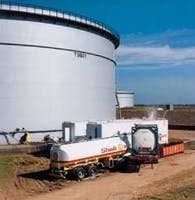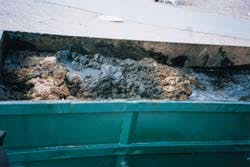Jan S. Hummer
Toftejorg Technology A/S
Baldershøj, Denmark
A mobile, automated tank-cleaning system, used in the past 3 years at more than 50 sites in Scandinavia and northern Europe, requires no tank entry or contact with hydrocarbons by personnel, and it has proven faster than manual systems.
Developed and marketed by Toftejorg Technology AS, Denmark, and called the Blabo system, it also simultaneously separates the resulting sludge. This allows nearly 100% recovery of oil and the least sludge for disposal.
Investment
The oil industry's five main divisions-exploration and production, transportation, storage, processing, and distribution/marketing-have devoted enormous amounts of capital and resources to the discovery and extraction of oil as well as to the questions of how the oil is processed, how it is distributed, and how it is sold.
Comparatively fewer resources have been invested in developing more-efficient ways of transporting oil. And almost nothing has been invested in more effective ways of storing oil products.
Most tanks are cleaned manually.
Cleaning tanks which have held white oil products, such as naphtha, gasoline, jet fuel, and diesel oils, is relatively easy and should require no more than 6-12 hr.
Cleaning tanks which have contained black products, such as crude oil, fuel oils, bitumen, and heavy vacuum gas oil, on the other hand, is not only difficult and time consuming but also can be risky and is always expensive.
Such tank cleaning for inspection and maintenance is therefore usually postponed as long as possible and normally occurs at intervals of as long as 8-12 years.
The largest tanks are crude-oil tanks which vary in size from 30,000 cu m up to more than 120,000 cu m (748,800 bbl). They have floating roofs, with diameters ranging from 40 to 80 m (120-240 ft), and heights of 18-22 m (55-66 ft).
Before a tank is opened for cleaning and after it has been emptied as thoroughly as possible, it is common to fill in 5,000-15,000 cu m (30,000-90,000 bbl) of gas-oil component and then, with built-in mixers, to stir the tank content for 1-4 weeks.
In this way, some of the hydrocarbons in the sludge area are dissolved in the gas oil, thereby minimizing the sludge volume to be removed. When the tank is subsequently opened for cleaning, a sludge layer of 30-50 cm is usually found.
This is equivalent to a volume of 500-1,500 cu m of sludge, which is then dug and sucked out of the tank. The cleaning contractor uses vacuum trucks and large volumes of water and gas oil to facilitate the manual labor of removing the sludge water mixture.
The mixture of sludge and water is then delivered to the refinery for further treatment and processing. It is pumped into separation tanks or into open concrete separation pits.
From here, the water is drained and the top level of oil sucked out and returned to crude. The remainder is disposed of either within or outside the refinery.
The total process may take 5-16 weeks.
Over the years, alternative mechanical or chemical cleaning methods have been developed. These primarily focus on reducing the amount of sludge by resuspending actions.
For various reasons, however, none has been entirely successful.
At best, they have transferred the problems to other tanks. At worst, they have generated considerable problems in fouling the desalter, heat exchangers, piping, furnaces, and the lower part of the crude distillation column.
In almost all these systems, relatively large volumes of gas oil components are utilized; these frequently have to be reprocessed. If the refinery is running at or near maximum capacity, this ultimately costs refining capacity and lost refining margin.
New system
Recent legislation has started to call for more frequent tank inspections. In such industrialized countries as Germany and Japan, laws already require tank inspection every 4-6 years.
As a result, some oil companies have begun to analyze other options and determine the true cost of having a tank taken out of service.
The real total cleaning costs are typically found to be higher than the price paid to the contractor for the manual removal of the sludge.
Between 1991 and 1993, Toftejorg developed and patented a process specifically geared to the cleaning of large crude and fuel-oil tanks. The Blabo system combines automated tank cleaning with simultaneous sludge separation.
The process delivers the cleaned out sludge in its three main components: clean oil (hydrocarbons), clean water, and solids (inorganic components).
By means of energy (elec tri city/
steam) alone and primarily using the treated sludge itself as the cleaning medium, the process can remove and separate 150-300 cu m/day of sludge. Fig. 1 [17790 bytes] shows the three parts of Toftejorg's Blabo system.
The first part, which is placed inside the tank to be cleaned, consists of several specially designed Toftejorg tank cleaning machines (rotating jet heads, or RJHs).
They are positioned inside the tank through existing tank openings so that all parts of the tank can be reached by jets of heated oil sludge. The RJHs are connected to the second part which is placed outside the tank.
This recirculation module consists of pumps, filters, heat exchangers, and hydrocyclones that treat and heat the sludge so that it can be recirculated into the tank through the RJHs.
In this way, more sludge is fluidized and can be pumped out for separation.
The third part of the cleaning system-the separation module-contains hydrocyclones, decanters, and high-speed centrifuges which separate the sludge into oil, water, and solids (Fig. 2 [24309 bytes]).
Before the RJHs are activated, the tank is inerted by nitrogen or flue gas to keep the oxygen content below 7-8 vol % while the cleaning process takes place.
When the tank has been emptied of sludge, it undergoes a hot-water wash, again using the RJHs. After this wash, the tank is opened for inspection and maintenance.
Fig. 3 [25155 bytes] presents a comparison of the Toftejorg method with other more common methods.
A tank containing 1,500 cu m of sludge consisting of 75-85 vol % hydrocarbons, 10-15 vol % water, and 5-10 vol % inorganics will normally be cleaned in 12-16 days. By other, manual methods, this operation could take from 5 to 8 weeks or even more.
With a traditional manual method, 65-75% of the volume of hydrocarbons may be recovered, and 600-800 cu m will require disposal. With the Blabo method, the hydrocarbon recovery will be 97-99%, and the amount for disposal is reduced by 60-80% to approximately 200 cu m. The recovered oil is of high quality.
Costs, applications
The most direct and obvious cost in connection with a traditional cleaning of a tank is payment to the contractor for removing the sludge and washing the tank.
Costs for establishing recirculation systems for reprocessing the gas oil; the lost refining margin; the cost of separation, transportation, and incineration of sludge; and the delay in the marketing of products are often forgotten and, in fact, not taken into consideration when total cost is envisioned.
In most cases, the total cost is 3-6 times the cost of the contractor.
For either a traditional (manual) method or the Toftejorg method for preparing a crude tank (60,000 cu m) for inspection and hot work, the costs specified in Table 1 [82291 bytes] must be considered in a comparison of overall cleaning costs.
Toftejorg's system has been used to clean tanks at more than 50 sites in Scandinavia and northern Europe during the last 3 years.
In a 30,000 cu m crude-oil tank operated by Dansk Shell AS at its refinery in Fredericia, Denmark (Fig. 4 - below), the Toftejorg unit had been exposed to a fire. The tank contained 1,100 cu m of oil/wax/water/debris. Total cleaning and separation time was 6-7 days with no man hours spent inside the tank. The hydrocarbon recovery was in excess of 98%.
Cleaning is under way on this 30,000 cu m (200,000 bbl) crude-oil tank. It contained 1,100 cu m of heavy sludge which required 7 days for the automated cleaning unit to clean and separate. Total hydrocarbon recovery was greater than 99% (Fig. 4).
From the 1,100 cu m of sludge, more than 19 cu m of inorganic solids were extracted. If the tank had been handled in the usual (manual) manner, most of this dirt would have been deposited in heat exchangers, furnaces, and distillation columns or in the fuel oil fraction.
For a 60,000 cu m crude-oil tank at the Esso Norway AS Tönsberg, Norway, refinery, the tank was cleaned without prior gas-oil circulation. Cleaning time was 2.5 weeks; hydrocarbon recovery was 98-99%. Total waste (solids) for disposal amounted to as little as 14 cu m (Fig. 5 - below).
At Esso's Tönsberg, Norway, refinery, 14 cu m (5 bbl) of solids were separated from 600 cu m of sludge in this 60,000 cu m (375,000 bbl) crude-oil tank. Specific weight of solids was approximately 1.8 (Fig. 5).
Two, 50,000-bbl crude oil tanks at the Doras terminal operated by Dansk Shell at Fredericia were cleaned in September and November 1994.
The cleaning was performed in less than a week with total separation of the sludge into clean water, hydrocarbons, and solids. Hydrocarbon recovery was greater than 98% of the original tank-bottom content.
At Esso Norway's Tönsberg refinery, a 30,000 cu m water ballast tank turned out to contain 800-900 cu m heavy fuel oil and water. Approximate sludge composition was 44% oil, 40% water, 16% inorganics.
The cleaning was performed in 16 operational days without personnel entering the tank. For the first time, the newly developed Toftejorg SNS (Single Nozzle Sweeper) tank-cleaning machine was applied.
At Svenska Shell AB's Gothenberg, Sweden, refinery, an SNS tank-cleaning machine was for the first time used on a 32,000 cu m crude-oil tank. Before personnel entered the tank for the preliminary inspection, 98% of hydrocarbons were removed.
The tank was cleaned in 9 operational days with total recovery of hydrocarbons, clean water, and 20 cu m of solids.
The Author
Jan S. Hummer is managing director of Toftejorg Services A/S and Toftejorg Technology A/S, two companies in the Danish Toftejorg Group. He worked for Shell International, The Hague, and later for Haldor Topsøe A/S as consultant to the Kuwaiti government. Hummer was also director for the European companies of International Service System. Before becoming involved with Toftejorg as its main shareholder, he was president of Pasilac A/S, now a part of the APV Group. Hummer holds an MS in chemical engineering from the Technical University of Copenhagen.
Copyright 1996 Oil & Gas Journal. All Rights Reserved.





